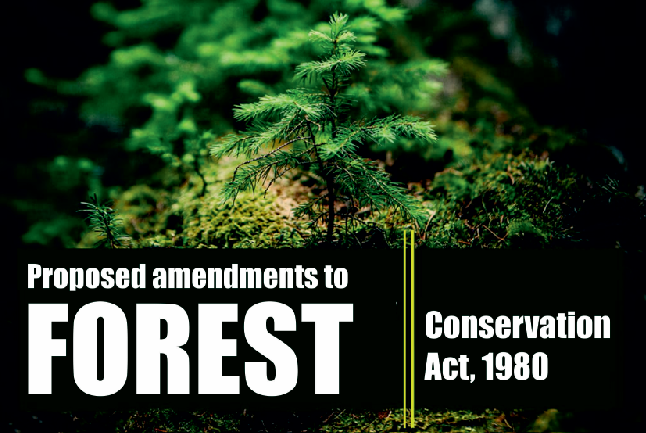
Govt proposes to redefine forests
- November 7, 2021
- 0
Last week, the Ministry for Environment, Forests and Climate Change (MoEFCC) published proposed amendments to the Forest Conservation Act, 1980, easing diversion of forests and exempting certain categories of development from the need to take clearance from the Ministry. The Ministry has invited feedback from state governments and the general public within 15 days. After examining the feedback, it will draw up a draft amendment, followed by a second round of public consultation before an amendment Bill is finally drawn up and tabled in Parliament.
Why is the Act being amended now?
It has been amended only once before, in 1988. Ministry officials have said the current definition of forests has locked land across the country; even private owners cannot utilise their own property for non-forestry purposes. Under the Act, any diversion of any forest land for any purpose, including assignment of leases, needs prior approval of the Centre.
In 1996, ruling in T N Godavarman Thirumulpad v Union of India, the Supreme Court had expanded the definition and scope of forest land to include all areas recorded as forest in any government record, irrespective of ownership, recognition and classification. Previously, the Act had applied largely to reserve forests and national parks. The court also expanded the definition of forests to encompass the “dictionary meaning of forests”, which would mean that a forested patch would automatically become a “deemed forest” even if it is not notified as protected, and irrespective of ownership. The order was also interpreted to presume that the Act is applicable over plantations in non-forest land.
Ministry officials said the amendment is proposed to “streamline provisions of the Act”. It has said the identification of forest land is subjective and arbitrary and that the “ambiguity” has “resulted into lot of resentment and resistance particularly from private individuals and organisations”.
The Ministry has also cited “strong resentment in the Ministry of Railways, Ministry of Road, Transport & Highways”, which too require forest clearance. Officials said these clearances usually take several years, in turn delaying infrastructure projects.
What are the proposed amendments?
- The Ministry has proposed that all land acquired by the Railways and Roads Ministries prior to 1980 be exempted from the Act. It says these lands had been acquired for expansion, but subsequently forests have grown in these areas, and the government is no longer able to use the land for expansion. If the amendment is brought in, these Ministries will no longer need clearance for their projects, nor pay compensatory levies to build there.
- For individuals whose lands fall within a state-specific Private Forests Act or come within the dictionary meaning of forest as specified in the 1996 Supreme Court order, the government proposes to allow “construction of structures for bona fide purposes” including residential units up to 250 sq m as a one-time relaxation.
- Defence projects near international borders will be exempted from forest clearance.
- Oil and natural gas extraction from forested lands will be permitted, but only if technologies such as Extended Reach Drilling are used.
- The Ministry has proposed doing away with levies for non-forestry purposes during the renewal of a lease, saying the double levy at the time of awarding of the lease and the renewal is “not rational”.
- Strip plantations alongside roads that would fall under the Act will be exempted.
What are the concerns?
- Activists and opposition leaders say the relaxation of forest rules will facilitate corporate ownership and the disappearance of large tracts of forests.
- About the exemption of forests on private land, even former forest officials said many forests will disappear. For instance, 4% land in Uttarakhand falls under private forests.
- Leaders such as Brinda Karat (CPM) have asked what will happen to tribals and forest dwelling communities — an issue the amendments do not address.
- Environmentalists say exemption for Roads and Railways on forest land acquired prior to 1980 will be detrimental to forests as well as wildlife – especially elephants, tigers and leopards.
- Environmentalists say one time exemption for private residences on private forest will lead to fragmentation of forests, and open areas such as the Aravalli mountains to real estate.
Do environmental groups note any positives?
They have welcomed the fact that the consultation paper has been public, and the decision to make changes through an amendment using the parliamentary process. Environmental lawyer Ritwick Dutta said that over the last decade and a half, irrespective of which party has been in power, the standard procedure has been to change laws through office memorandums and letters and not through statutory process.
Environmental groups have also acknowledged that:
- The MoEFCC has pointed out where the pressure for forest land diversion has been coming from — Ministries such as Rail and Roads — and allowed a public debate on it.
- It has proposed making forest laws more stringent for notified forests, making offences non-bailable with increased penalties including imprisonment of up to one year.
- It has disallowed any kind of diversion in certain forests.
- It has attempt to define and identify forests once and for all — something that has been often ambiguous.
Esha Roy – Indian Express
पर्यावरण, वन और जलवायु परिवर्तन मंत्रालय (MoEFCC) ने वन संरक्षण अधिनियम, 1980 में प्रस्तावित संशोधनों को प्रकाशित किया, जिसमें वनों के डायवर्जन को आसान बनाया और कुछ श्रेणियों के विकास को मंत्रालय से मंजूरी लेने की आवश्यकता से छूट दी गई। मंत्रालय ने राज्य सरकारों और आम जनता से 15 दिनों के भीतर फीडबैक मांगा है। फीडबैक की जांच के बाद, यह एक मसौदा संशोधन तैयार करेगा, उसके बाद एक संशोधन विधेयक को अंतिम रूप से संसद में पेश करने से पहले सार्वजनिक परामर्श का दूसरा दौर तैयार करेगा।
अब अधिनियम में संशोधन क्यों किया जा रहा है?
इसे केवल एक बार पहले 1988 में संशोधित किया गया है। मंत्रालय के अधिकारियों ने कहा है कि वनों की वर्तमान परिभाषा ने देश भर में भूमि को कैद कर दिया हैय यहां तक कि निजी मालिक भी गैर-वानिकी उद्देश्यों के लिए अपनी संपत्ति का उपयोग नहीं कर सकते हैं। अधिनियम के तहत, पट्टों के असाइनमेंट सहित किसी भी उद्देश्य के लिए किसी भी वन भूमि के किसी भी मोड़ के लिए केंद्र की पूर्व स्वीकृति की आवश्यकता होती है।
1996 में, टीएन गोदावर्मन थिरुमुलपाद बनाम भारत संघ में फैसला सुनाते हुए, सुप्रीम कोर्ट ने वन भूमि की परिभाषा और दायरे का विस्तार किया था, ताकि स्वामित्व, मान्यता और वर्गीकरण के बावजूद, किसी भी सरकारी रिकॉर्ड में वन के रूप में दर्ज सभी क्षेत्रों को शामिल किया जा सके। इससे पहले, अधिनियम वनों और राष्ट्रीय उद्यानों को बड़े पैमाने पर आरक्षित करने के लिए लागू किया गया था। अदालत ने ‘‘जंगलों के शब्दकोश अर्थ’’ में शामिल करने के लिए वनों की परिभाषा का भी विस्तार किया, जिसका अर्थ यह था कि एक वनाच्छादित पैच स्वामित्व के बावजूद स्वचालित रूप से ‘‘डीम्ड वन’’ बन जाएगा, भले ही इसे संरक्षित के रूप में अधिसूचित नहीं किया गया हो। आदेश की व्याख्या यह मानते हुए भी की गई थी कि यह अधिनियम गैर-वन भूमि में वृक्षारोपण पर भी लागू है।
मंत्रालय के अधिकारियों ने कहा कि संशोधन ‘‘अधिनियम के प्रावधानों को कारगर बनाने’’ के लिए प्रस्तावित है। इसने कहा है कि वन भूमि की पहचान व्यक्तिपरक और मनमानी है और ‘‘अस्पष्टता’’ के परिणामस्वरूप विशेष रूप से निजी व्यक्तियों और संगठनों से बहुत नाराजगी और प्रतिरोध हुआ है’’।
मंत्रालय ने ‘‘रेल मंत्रालय, सड़क, परिवहन और राजमार्ग मंत्रालय में कड़ी नाराजगी’’ का भी हवाला दिया है, जिसे भी वन मंजूरी की आवश्यकता है। अधिकारियों ने कहा कि इन मंजूरी में आमतौर पर कई साल लग जाते हैं, जिससे बुनियादी ढांचा परियोजनाओं में देरी होती है।
क्या हैं प्रस्तावित संशोधन?
- मंत्रालय ने प्रस्ताव किया है कि 1980 से पहले रेलवे और सड़क मंत्रालयों द्वारा अधिग्रहित सभी भूमि को अधिनियम से छूट दी जाए। इसमें कहा गया है कि इन जमीनों को विस्तार के लिए अधिग्रहित किया गया था, लेकिन बाद में इन क्षेत्रों में जंगल उग आए हैं, और सरकार अब विस्तार के लिए भूमि का उपयोग करने में सक्षम नहीं है। यदि संशोधन लाया जाता है, तो इन मंत्रालयों को अब अपनी परियोजनाओं के लिए मंजूरी की आवश्यकता नहीं होगी और न ही वहां निर्माण के लिए प्रतिपूरक शुल्क का भुगतान करना होगा।
- उन व्यक्तियों के लिए जिनकी भूमि राज्य-विशिष्ट निजी वन अधिनियम के अंतर्गत आती है या 1996 के सर्वोच्च न्यायालय के आदेश में निर्दिष्ट वन के शब्दकोश अर्थ में आती है, सरकार आवासीय इकाइयों सहित ‘‘वास्तविक उद्देश्यों के लिए संरचनाओं के निर्माण’’ की अनुमति देने का प्रस्ताव करती है। एकमुश्त छूट के रूप में 250 वर्ग मीटर तक।
- अंतरराष्ट्रीय सीमाओं के पास रक्षा परियोजनाओं को वन मंजूरी से छूट दी जाएगी।
- वन भूमि से तेल और प्राकृतिक गैस निकालने की अनुमति दी जाएगी, लेकिन केवल तभी जब विस्तारित पहुंच ड्रिलिंग जैसी तकनीकों का उपयोग किया जाएगा।
- मंत्रालय ने लीज के नवीनीकरण के दौरान गैर-वानिकी प्रयोजनों के लिए लेवी को समाप्त करने का प्रस्ताव दिया है, यह कहते हुए कि लीज प्रदान करने और नवीनीकरण के समय डबल लेवी ‘‘तर्कसंगत नहीं’’ है।
- अधिनियम के अंतर्गत आने वाली सड़कों के किनारे पट्टीदार वृक्षारोपण को छूट दी जाएगी।
चिंताएं क्या हैं?
- कार्यकर्ताओं और विपक्षी नेताओं का कहना है कि वन नियमों में ढील से कॉर्पोरेट स्वामित्व और जंगलों के बड़े हिस्से के गायब होने का खतरा बढ़ जायेगा।
- निजी भूमि पर वनों की छूट के बारे में पूर्व वन अधिकारियों ने भी कहा कि कई जंगल गायब हो जाएंगे। उदाहरण के लिए, उत्तराखंड में 4 प्रतिशत भूमि निजी वनों के अंतर्गत आती है।
- बृंदा करात (सीपीएम) जैसे नेताओं ने पूछा है कि आदिवासियों और वनवासी समुदायों का क्या होगा – एक ऐसा मुद्दा जिसे संशोधन संबोधित नहीं करते हैं।
पर्यावरणविदों का कहना है कि 1980 से पहले अधिग्रहित वन भूमि पर सड़कों और रेलवे के लिए छूट वनों के साथ-साथ वन्यजीवों – विशेष रूप से हाथियों, बाघों और तेंदुओं के लिए हानिकारक होगी।
पर्यावरणविदों का कहना है कि निजी वनों पर निजी आवासों के लिए एक बार की छूट से वनों का विखंडन होगा, और अरावली पहाड़ों जैसे खुले क्षेत्रों में अचल संपत्ति हो जाएगी।
क्या पर्यावरण समूह कोई सकारात्मक नोट करते हैं?
उन्होंने इस तथ्य का स्वागत किया है कि परामर्श पत्र सार्वजनिक कर दिया गया है, और संसदीय प्रक्रिया का उपयोग करके संशोधन के माध्यम से परिवर्तन करने का निर्णय लिया गया है। पर्यावरण वकील ऋत्विक दत्ता ने कहा कि पिछले डेढ़ दशक में, चाहे कोई भी पार्टी सत्ता में रही हो, मानक प्रक्रिया कार्यालय ज्ञापनों और पत्रों के माध्यम से कानूनों को बदलने की रही है, न कि वैधानिक प्रक्रिया के माध्यम से।
पर्यावरण समूहों ने भी स्वीकार किया है किः
- एमओईएफसीसी ने बताया है कि वन भूमि परिवर्तन के लिए दबाव कहाँ से आ रहा है – रेल और सड़क जैसे मंत्रालय – और इस पर एक सार्वजनिक बहस की अनुमति दी।
- इसने अधिसूचित वनों के लिए वन कानूनों को और अधिक सख्त बनाने का प्रस्ताव किया है, अपराधों को गैर-जमानती बनाने के साथ-साथ एक वर्ष तक के कारावास सहित बढ़े हुए दंड का प्रावधान किया है।
- इसने कुछ वनों में किसी भी प्रकार के परिवर्तन की अनुमति नहीं दी है।
- इसमें हमेशा के लिए वनों को परिभाषित करने और पहचानने का प्रयास किया गया है – कुछ ऐसा जो अक्सर अस्पष्ट रहा है।
Esha Roy – Indian Express































































